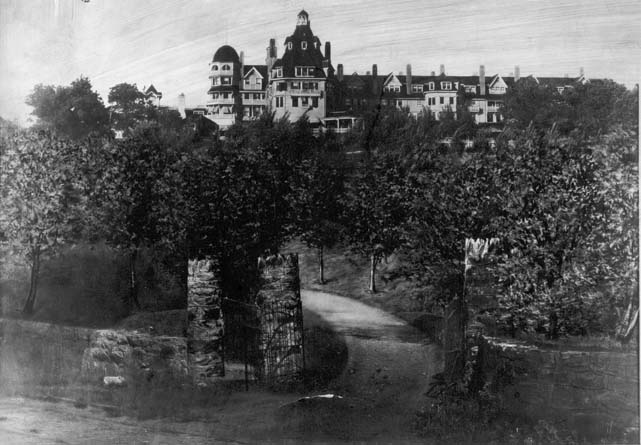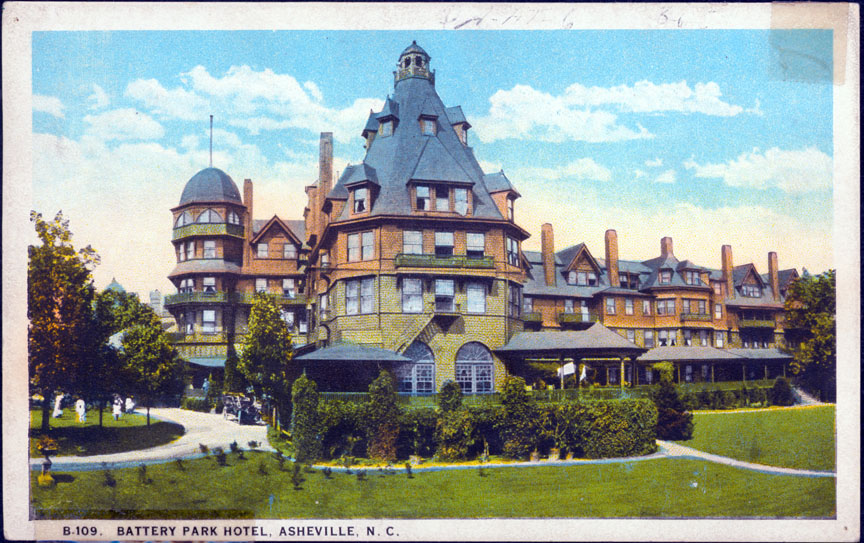On July 12, 1886, the original Battery Park Hotel opened in downtown Asheville. Owned by Col. Franklin Coxe, the rambling property stretched 475 feet in length and occupied 25 acres atop a hill that once stood 125 feet above the downtown square.
The hotel was sold to E.W. Grove in 1920. By 1923, the building was razed and the hill demolished by steam shovels. Grove used the removed earth to fill in the nearby gullies, creating Coxe Avenue. A year later, Grove opened the second Battery Park Hotel, which exists today as the Battery Park Senior Apartments, located at 1 Battle Square. According to Lou Harshaw‘s 2007 book Asheville Mountain Majesty, the seventh floor of the present-day building would have been the height of the original hilltop.
In Nan Chase’s 2007 book, Asheville: A History, the local writer notes the modern amenities that Coxe’s original hotel offered. Chase writes that the property was equipped with “bathrooms with hot and cold running water, electric light bulbs, steam radiators, a fireplace for every room, ballrooms and dining rooms, a bowling alley, billiard rooms (even one for members of the fair sex to enjoy on their own), and an unusual hydraulic elevator that used a column of water to raise and lower the passenger compartment.”
Anticipation for Coxe’s Battery Park lodging was evident in early newspaper reports. On June 9, 1886, The Asheville Citizen previewed the soon-to-open hotel, courtesy of a “descriptive pamphlet” it had received. According to the paper, the brochure showed “a lithographic picture in color of the hotel, a picturesque … rambling Queen Anne structure, with tower and gable and balcony and lattice window and portico and all the elements of the quaint antique mingled with the practical modern.”
The hotel’s popularity was immediate. Three weeks after its opening, The Courier-Journal, a newspaper based out of Louisville, Ky., published a correspondence from the hotel. The writer, identified only as P.B.S., was among the Battery Park’s first guests. His missive, published on Aug. 4, 1886, noted the “admirable” location of the new hotel: “It is pitched on the highest hill in the town, from which you can see all that is beautiful and grand on every side.” Later on, P.B.S. paid compliment to its owner, writing “Col. Frank Cox[e] has plenty of money, fine judgment and strong nerve, and in erecting this splendid hotel on this elevated spot is the bold leader in this and a score of such enterprises in this vast health resort.”

A few weeks later, on Aug. 19, 1886, The Asheville Citizen featured a similar piece, composed by another early guest, former Philadelphia Mayor Daniel M. Fox. According to the paper, the article was originally published in the Philadelphia Times. In the piece, Fox wrote:
“Asheville is in the heart of the Black Mountains of Western North Carolina and until within a very few years past, was comparatively unknown, owing to lack of railroad connections [the first train arrived to Asheville in 1880], but energy, enterprise and local pride have opened it to the country. Now it promises to be one of the most prominent resorts of the South. The Western North Carolina Railroad has executed through these mountains difficult and elaborate problems of engineering skill. The climbing of the ascents from Old Fort to Swannanoa tunnel is accomplished by the most startling features of tunnel, trestle and grade, the last varying from 60 to 115 feet per mile amid a region not so wild and rugged as the Catskills or the White Mountains, but serene, restful and beautiful, clothed with verdure so prolific that flowers and vegetation grow to the top of every peak. …
In this delightful and progressive little town, located upon a lovely plateau between the Blue Ridge and the Alleghenies, is old Battery Porter, so named during the war from earthworks erected by the Confederates. Here in the midst of an enclosure made by the fortifications is located the Battery Park Hotel, built by Colonel Frank Coxe, of Philadelphia, a kinsman of Senator Eckley B. Coxe and vice president of the Western North Carolina Railroad. For miles in every direction from Mount Mitchell to Caesar’s Head the hotel commands charming and impressive views. It is impossible to convey to you the impression produced by the play of the clouds on the splendid range of peaks in view of us. The house opened on the 12th of last month and has been filled ever since. Lured by the delightful surroundings and the ozone and health-giving properties of this atmosphere a tide of Northern people has set in which gives promise of continuing through the fall and winter seasons. They find not a hospital, but a sanitarium in the best sense of the term, where they are able to enjoy the beauties of the country with all the relish of vigorous health. But is it cool? ask my friends. The temperature throughout this summer has ranged from 65 degrees to 77 degrees, with one day in which the thermometer touched 81 degrees. What do you think of that, and in North Carolina?”




It was so beautiful!!!!! I so wish I could have lived during this time in history.